Ever wondered what makes Japanese whiskey so special? You’re not alone. This spirit has taken the world by storm. Japanese whiskey began around 1870, with the first commercial production in 1923.
We’ll uncover nine secrets from master distillers that set it apart. Ready to sip some knowledge?
Key Takeaways
Japanese whiskey started in 1923, blending Scottish methods with Japanese precision to create a smooth, refined spirit.
Mizunara oak barrels add unique flavors like sandalwood and coconut to Japanese whiskey, setting it apart from other types.
Cultural principles like Kaizen (continuous improvement) and Monozukuri (craftsmanship) shape how Japanese distillers make whiskey.
New Japanese whiskey distilleries have opened since 2008, bringing fresh ideas and techniques to the industry.
Japanese whiskey pairs well with various foods, from seafood to grilled meats, and can be enjoyed neat, on the rocks, or in cocktails like the popular Highball.
Table of Contents
What Defines Japanese Whiskey
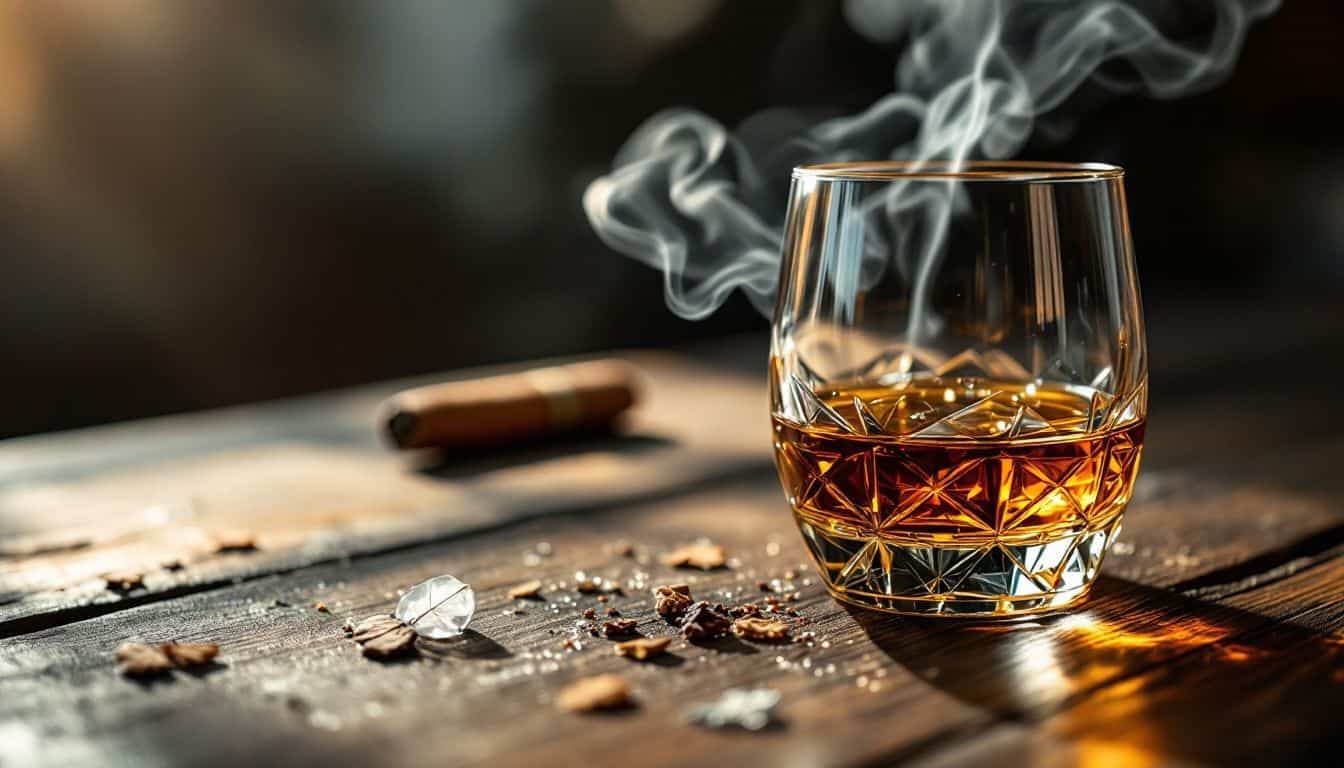
Japanese whiskey stands out with its smooth, refined taste. It blends Scottish traditions with Japanese precision, creating a spirit that’s both familiar and fresh.
Distinct Characteristics

Japanese whisky stands out with its smooth, delicate flavor. It’s often lighter than Scotch but packs a punch of complex tastes. Barley forms the base, and continuous stills help create a refined spirit.
The aging process in various casks – bourbon, sherry, or wine – adds depth. This mix of methods gives each sip a unique profile.
Mizunara oak barrels are a secret weapon for many distillers. These rare Japanese trees impart flavors like sandalwood and coconut. The result? A whisky that’s both familiar and exotic.
Most Japanese whiskies also have a lower alcohol content. This makes them easier to drink and perfect for sipping neat or in cocktails. For more info on these special spirits, check out these Japanese whisky reviews.
Comparisons to Scotch and American Whiskeys
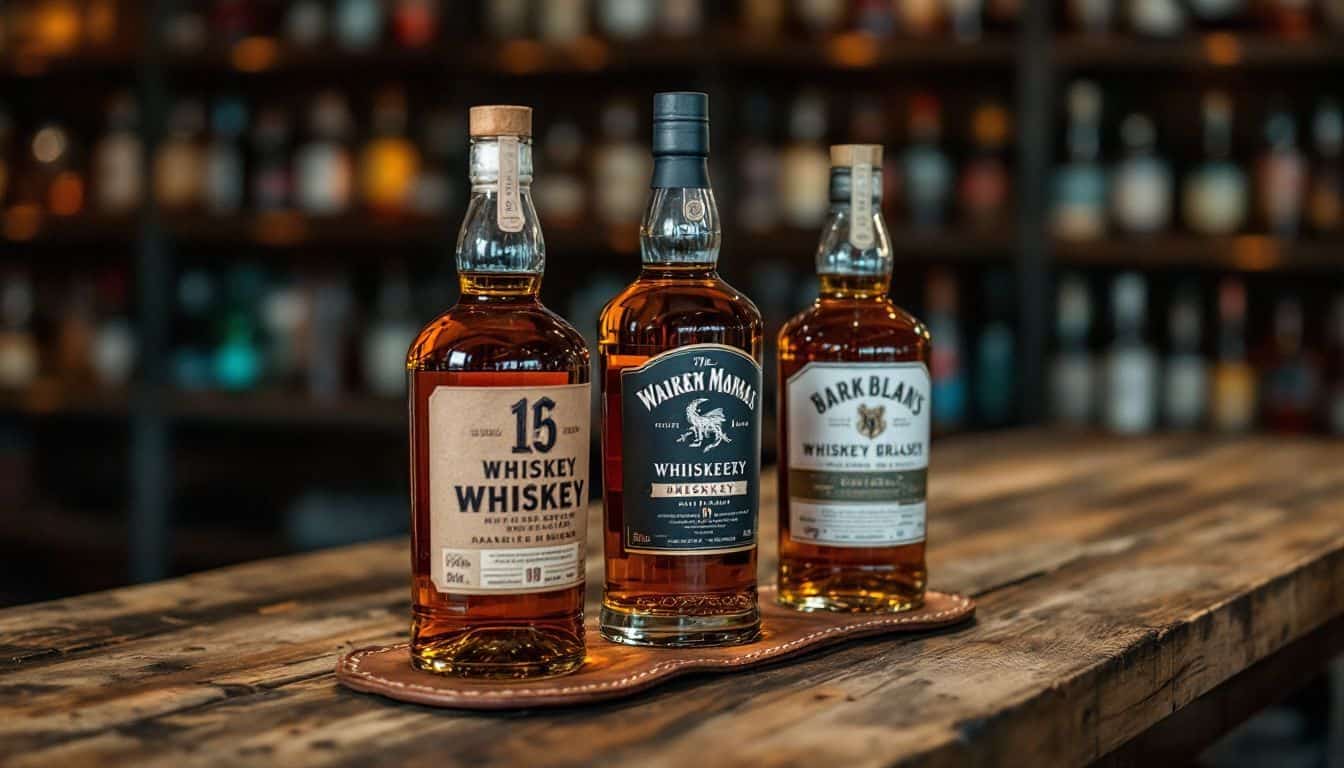
Let’s dive into how Japanese whisky stacks up against its Scotch and American cousins. Here’s a quick comparison to help you understand the differences:
| Aspect | Japanese Whisky | Scotch Whisky | American Whiskey |
|---|---|---|---|
| Spelling | Whisky | Whisky | Whiskey |
| Flavor Profile | Less peated, subtle | Often peated, smoky | Sweet, rich |
| Mouthfeel | Lighter, delicate | Full-bodied | Smooth, creamy |
| Aging | Varied, often shorter | Minimum 3 years | Varies by type |
| Main Grain | Malted barley | Malted barley | Corn, rye, wheat |
Japanese whisky tends to be drier than American bourbon or rye. It shares more similarities with Scotch, but with its own twist. The flavor is often less intense, making it a great choice for whisky newbies. Japanese distillers focus on balance and precision, creating a smooth sip. Their attention to detail shows in every glass.
History of Japanese Whiskey
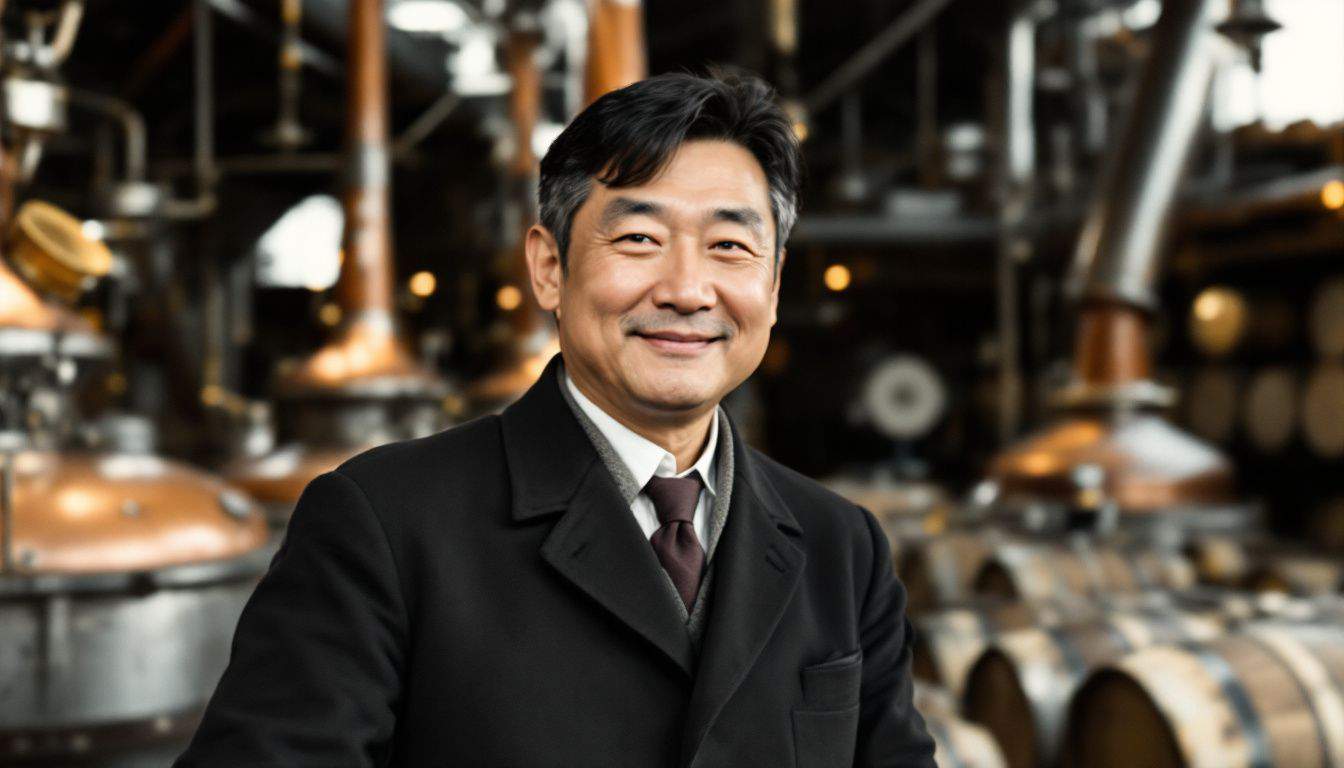
Japanese whiskey’s story is a tale of East meets West. It all kicked off in the 1920s when a curious chemist named Masataka Taketsuru jetted off to Scotland.
Origins and Influences
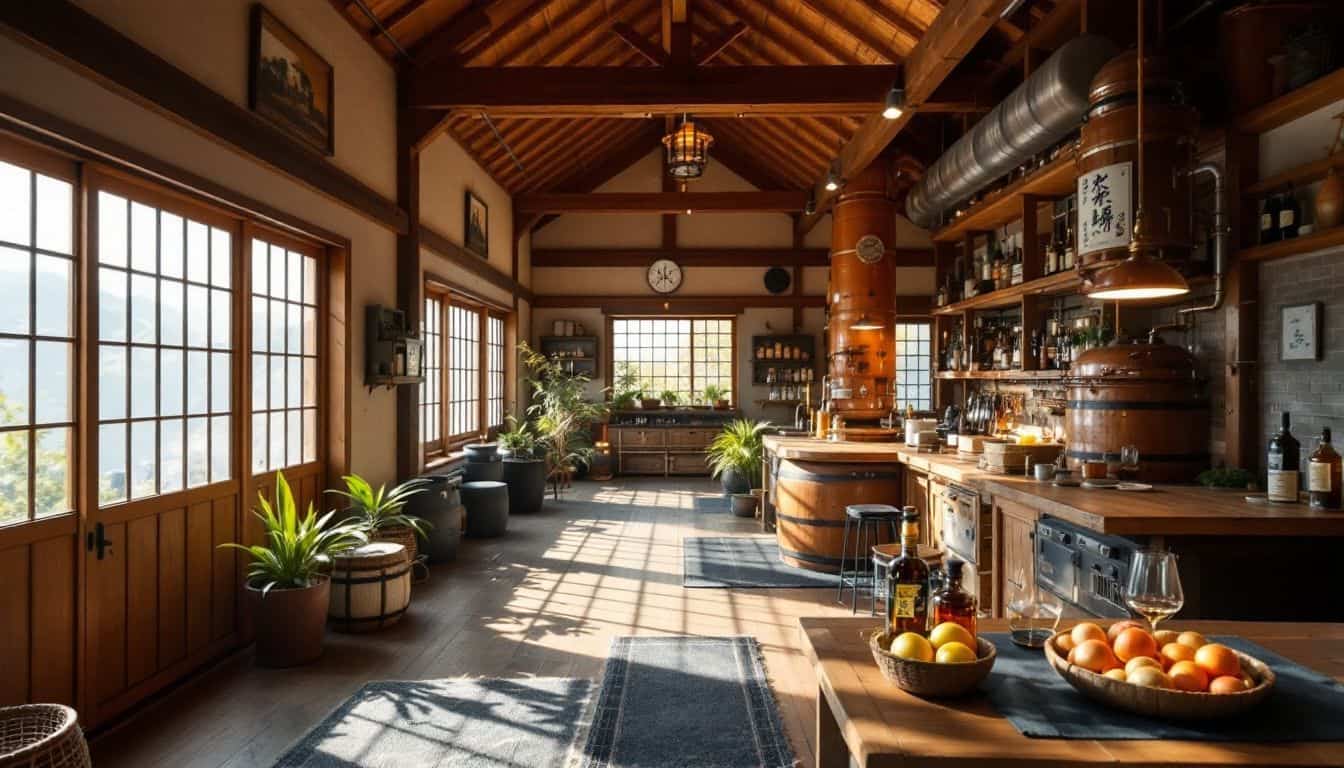
Japanese whiskey’s roots trace back to 1923. That’s when Shinjiro Torii opened the Yamazaki distillery. But the real spark came from Masataka Taketsuru. He studied in Scotland and brought back vital whisky-making secrets.
These two pioneers laid the groundwork for a new spirit.
Scotch whisky heavily influenced early Japanese production. Taketsuru’s Scottish training shaped his methods. Yet, Japanese distillers soon put their own spin on things. They tweaked techniques to suit local tastes and ingredients.
This blend of Scottish know-how and Japanese innovation created something special. By 1929, Suntory released Shirofuda – Japan’s first official whisky. It didn’t take long for the world to notice its quality.
Evolution and Innovations

Building on its origins, Japanese whisky kept growing. Makers tried new things. They mixed different flavors in one distillery. This was new. Most others didn’t do it.
Japan’s whisky got better fast. In the 1980s, Suntory sold 12.4 million cases of “Old” whisky. That’s a lot! But then, people drank less whisky. Things changed in 2008. Highballs became popular.
These drinks mix whisky and soda. They’re light and fun. TV helped too. In 2014, a show called “Massan” made whisky cool again. People loved it.
Innovation is not about saying yes to everything. It’s about saying NO to all but the most crucial features. – Steve Jobs
How Japanese Whiskey Is Made
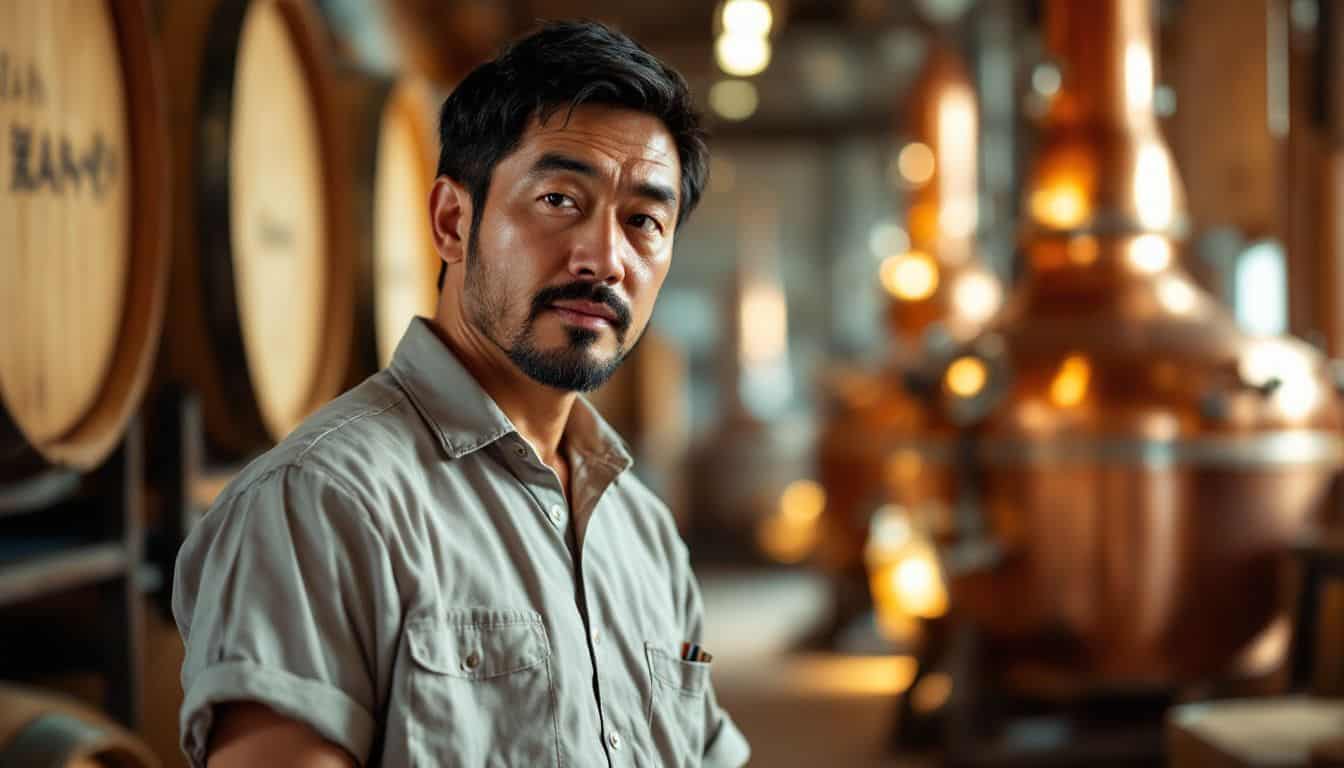
Japanese whiskey-making is an art form. It blends old traditions with new tech to create something special.
Techniques for Single-Distillery Blending
Japanese whisky makers are masters of blending. They mix different whiskies from a single distillery to create amazing flavors. Nikka, a top brand, uses thousands of whisky types in their blends.
They even throw in some experimental batches for extra zing. It’s like cooking with a huge spice rack – more options mean tastier results!
Suntory, another big name, takes blending seriously too. Their experts taste over 200 whiskies every day. That’s a lot of sipping! They mix and match until they find the perfect combo.
It’s not just about throwing stuff together. These pros use their noses and taste buds to craft whisky that’ll make you go “Wow!” with every sip.
Role of Mizunara Oak
Mizunara oak is the secret weapon of Japanese whisky makers. This rare wood adds magic to their spirits. It takes time – 15 to 20 years – for the whisky to soak up all the goodness.
But oh, is it worth the wait! The result? A drink that tastes like a walk through a Japanese forest. Think sandalwood, coconut, and spices… with a hint of incense. It’s like sipping on a zen garden!
Fancy a glass of this liquid gold? Be ready to open your wallet wide. Mizunara oak is hard to come by and pricey. But for whisky lovers, it’s a treat worth splurging on. The flavors are so complex, you’ll discover something new with each sip.
It’s not just a drink – it’s an experience that’ll transport you straight to Japan.
Varieties in Production Methods
Japanese whiskey makers use a mix of old and new methods. They blend tradition with innovation to create their unique spirits.
- Malting: Some distilleries malt their own barley, while others import malted barley. This step affects the whiskey’s flavor profile.
- Fermentation: Yeast strains vary between distilleries. Some use local yeasts for a distinct taste.
- Distillation: Pot stills and column stills are both used. The choice impacts the final product’s character.
- Aging: Casks made from Mizunara oak add a spicy, incense-like note. Cherry wood casks impart a subtle sweetness.
- Blending: Master blenders combine different whiskeys to create complex flavors. This art form is crucial in Japanese whiskey making.
- Water source: Pure mountain springs provide soft water. This element is key to the whiskey’s smooth texture.
- Peat: Some distilleries use peated malt for a smoky flavor. Others avoid it for a cleaner taste.
- Climate: Japan’s varied climate affects aging. Hot summers and cold winters create unique maturation conditions.
- Finishing: Extra aging in different casks adds layers of flavor. Wine, sherry, or bourbon barrels are popular choices.
Cultural Impact on Japanese Whiskey
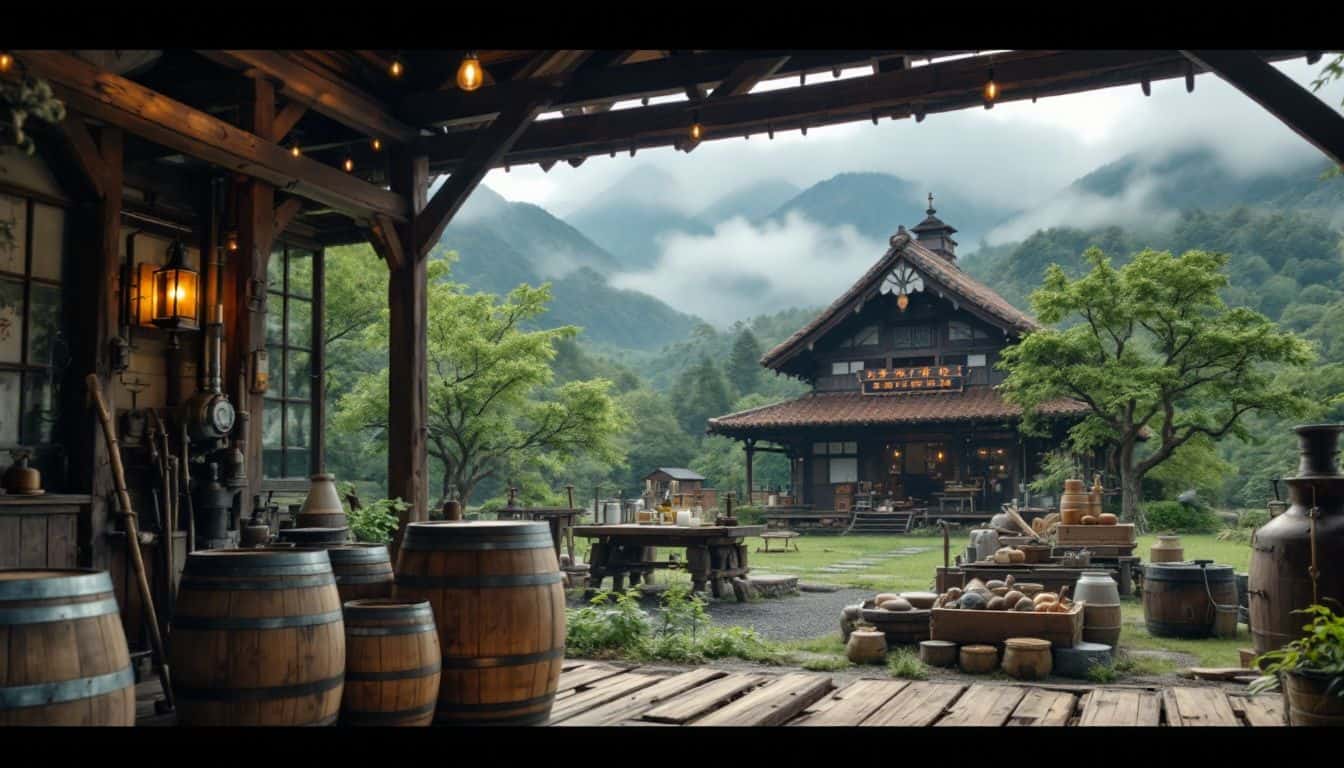
Japanese whiskey reflects deep cultural roots. It’s a blend of tradition and innovation, shaped by age-old principles.
Principles of Kaizen
Kaizen is a big deal in Japanese whiskey-making. It’s all about getting better, bit by bit, every single day. Distillers use this idea to tweak their methods and recipes. They’re always on the hunt for tiny ways to boost flavor.
It’s like they’re playing a never-ending game of “how can we make this whiskey even yummier?”.
Kaizen is the heartbeat of our craft. It’s in every drop we distill. – Suntory Master Blender
This mindset shapes how Japanese distilleries work. They don’t just settle for “good enough.” Instead, they keep pushing for that perfect sip. Next up, we’ll look at how the art of Monozukuri influences Japanese whiskey.
The Art of Monozukuri
Monozukuri is the heart of Japanese whiskey-making. It’s all about loving what you do and doing it really well. Think of it like cooking your favorite meal – you pick the best ingredients, follow the recipe carefully, and add your own special touch.
That’s how Japanese distillers make their whiskey. They focus on every little detail, from choosing the perfect water to aging the spirit just right.
This art isn’t just about making whiskey. It’s about creating something special that people will love. Japanese distillers pour their hearts into each bottle. They use old methods and new ideas to make whiskey that’s truly one-of-a-kind.
It’s this mix of tradition and innovation that makes Japanese whiskey so amazing. So next time you sip some, think about all the care that went into making it. That’s the magic of monozukuri!
Influence of Shun
Shun is a big deal in Japanese whiskey. It’s all about making whiskey that fits each season. Think of it like this: the weather changes, and so does the whiskey. Cool, right? Japanese distillers pay close attention to these shifts.
They use them to create whiskeys with special flavors.
I once visited a distillery in Japan during fall. The air was crisp, and the leaves were turning. The master distiller told me, “This is when our whiskey really shines.” He wasn’t kidding.
The whiskey we tasted had hints of autumn – spicy and warm. It’s amazing how nature plays a part in crafting these drinks. Next, let’s look at some famous Japanese whiskey brands you might want to try.
Prominent Japanese Whiskey Distilleries

Japanese whiskey distilleries are the heart and soul of this booming industry. From old-school giants to fresh-faced newcomers, each brings something special to the table. Want to know which ones are shaking things up? Keep reading!
Pioneers Before 2008
Japanese whiskey’s roots run deep. Let’s explore the trailblazers who shaped this spirit before 2008.
- Suntory: Founded by Shinjiro Torii in 1923, this powerhouse kicked off Japan’s whiskey journey. Yamazaki, their first distillery, still crafts some of the most sought-after drams today.
- Nikka: Masataka Taketsuru, often called the “Father of Japanese Whisky,” started Nikka in 1934. His Yoichi distillery in Hokkaido produces bold, peaty malts that’ll knock your socks off.
- Hakushu: Suntory’s mountain distillery, opened in 1973, makes fresh, green whiskeys. Think crisp apples and pine – perfect for a summer highball!
- Miyagikyo: Nikka’s second distillery, built in 1969, focuses on lighter, fruitier styles. It’s like biting into a ripe pear… with a kick!
- Fuji Gotemba: Kirin’s whiskey arm, started in 1973, sits at the foot of Mount Fuji. They use snow melt in production – talk about pure water!
- White Oak: The smallest of the bunch, this Osaka distillery has been quietly making whiskey since 1984. It’s a hidden gem waiting to be discovered.
- Chita: Suntory’s grain whiskey distillery, opened in 1972, is the backbone of many blended whiskies. It’s the unsung hero of Japanese whiskey!
Emerging Distilleries Post-2008
Japanese whiskey has seen a boom in new distilleries since 2008. Let’s explore some of these exciting newcomers shaking up the scene:
- Chichibu Distillery: Opened in 2008 by Ichiro Akuto, it’s the first new licensed distillery in 35 years. They’re known for bold flavors and experimental aging.
- Akkeshi Distillery: Located in Hokkaido, they use local peat and sea air to create unique, maritime-influenced whiskies.
- Mars Tsunuki: A branch of the Mars Shinshu distillery, they opened in 2016 in Kagoshima. Their warm climate speeds up aging.
- Kanosuke Distillery: Founded in 2017, they’re making waves with their coastal-influenced spirits and sleek bottle designs.
- Kyoto Miyako Distillery: Opened in 2019, they blend traditional Japanese craftsmanship with modern techniques.
- Kujū Distillery: Nestled in the mountains of Oita, they use local barley and pure spring water for their whiskies.
- Sakurao Distillery: Known for their gin, they started whiskey production in 2018, aiming for a light, fruity style.
- Asaka Distillery: Part of the Yamazakura brand, they began distilling in 2016, focusing on grain whiskies.
- Nagahama Distillery: Japan’s smallest distillery, they produce unique whiskies with a hands-on approach.
- Shizuoka Distillery: Opened in 2016, they use a mix of Japanese and imported malts for diverse flavor profiles.
How to Taste and Appreciate Japanese Whiskey
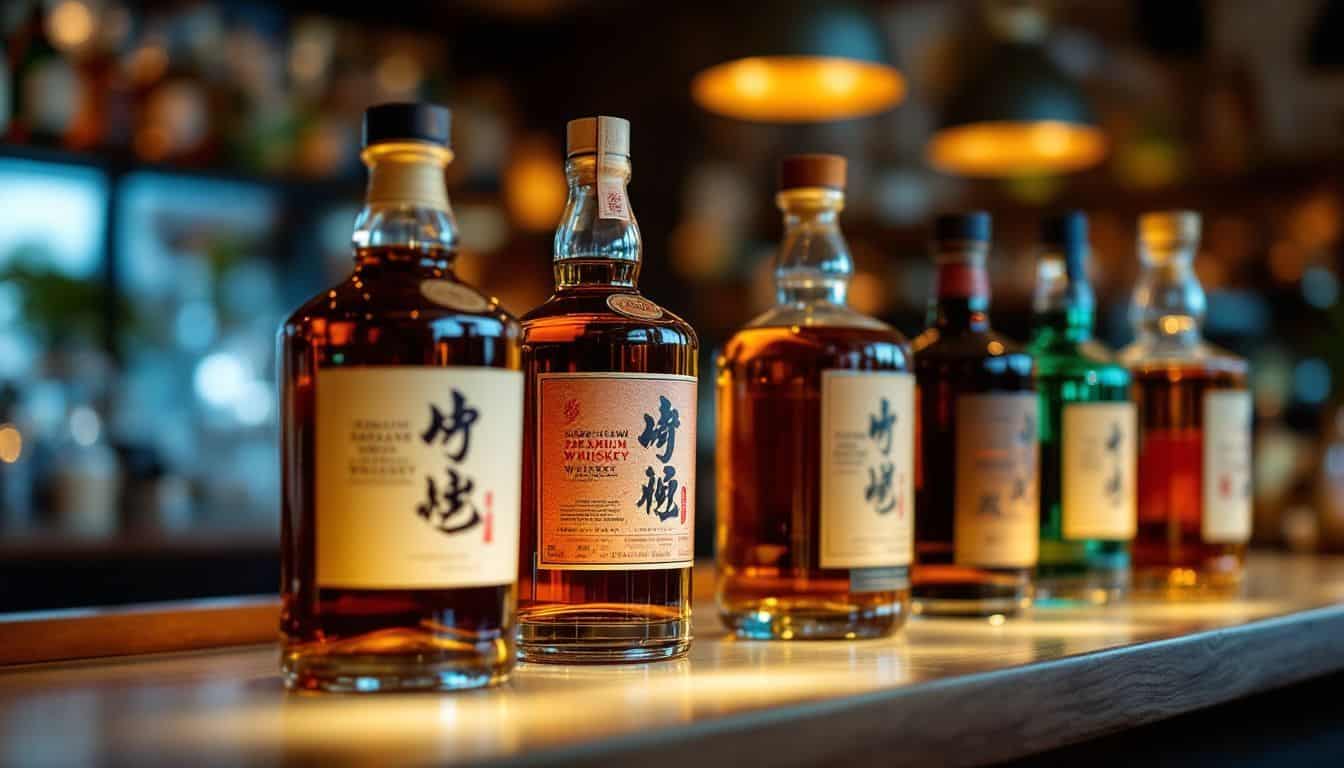
Ready to sip like a pro? Let’s dive into the art of tasting Japanese whiskey! We’ll explore the best ways to savor every drop… and maybe even impress your friends. Keep reading to become a whiskey whiz in no time!
Techniques for Proper Tasting
Let’s explore the art of tasting Japanese whiskey! First, take a good look at your drink. Notice its color and how clear it is. This tells you a lot about its age and how it was made.
Next, give it a sniff. Don’t stick your nose right in – that’ll just burn. Instead, hold the glass at chest level and breathe in gently. You’ll pick up all sorts of scents this way.
Now for the fun part – tasting! Take a small sip and let it coat your tongue. Notice how it feels in your mouth. Is it smooth or fiery? Sweet or spicy? Here’s a tip: add a few drops of water to your whiskey.
It might sound odd, but it can really open up new flavors and smells. I learned this trick at a tasting in Tokyo, and it’s a game-changer! There’s no right or wrong way to enjoy whiskey.
The best way is whatever makes you happy.
Recommendations on Glassware and Serving
Picking the right glass can make your Japanese whiskey experience even better. Here’s how to serve it like a pro:
- Tulip-shaped glasses: Go for a Glencairn glass. Its shape traps aromas, letting you catch all the whiskey’s scents.
- Temperature matters: Serve your whiskey at room temp (59-64°F). This brings out the best flavors.
- Ice cubes: If you like it cold, use one large, clear ice cube. It melts slower, keeping your drink from getting watery.
- Neat or with water: Try it neat first. Then, add a few drops of water to open up new flavors.
- Highball glasses: For cocktails like a Japanese Highball, use a tall, narrow glass. It keeps the fizz longer.
- Nosing glasses: These have a wide bowl and narrow top. Perfect for sniffing out those subtle aromas.
- Serving amount: Pour about 1-1.5 ounces. This lets you savor without overwhelming your palate.
- Whiskey stones: These keep your drink cool without diluting it. Great for sipping slowly.
Now that we’ve covered glassware and serving, let’s dive into how to taste and appreciate Japanese whiskey.
Famous Japanese Whiskey Brands and Selections

Let’s dive into some top-notch Japanese whiskey brands… but hold your horses! We’ve got more juicy secrets to spill before we get there. Stick around – you won’t want to miss this!
Top Affordable Choices
Japanese whiskey doesn’t have to break the bank. Let’s explore some wallet-friendly options that’ll make your taste buds dance without emptying your purse.
- Nikka Coffey Grain Whisky: At $40, this gem is a steal. It’s creamy and sweet, perfect for sipping on a girls’ night in. The smooth texture might remind you of vanilla ice cream – yum!
- Suntory Toki: Priced at just $24, this whisky is a highball’s best friend. It’s got zesty grapefruit notes and a hint of almond – like a fancy cocktail in a bottle. Mix it with soda for a refreshing summer drink.
- Hibiki Japanese Harmony: This blend is a bit pricier but worth every penny. It’s smooth as silk with hints of honey and orange peel. Treat yourself to this one when you’ve had a tough week.
- Yamazaki Single Malt: If you’re feeling fancy, this is your go-to. It’s got a rich, complex flavor that’ll make you feel like a whisky pro. Sip it neat to really savor the taste.
- Nikka From The Barrel: Don’t let the simple bottle fool you – this whisky packs a punch. It’s bold and spicy, perfect for those who like their drinks with a kick.
According to the whiskey and bourbon experts at Bourbon and Boots, Japanese whisky is gaining popularity in the U.S. for its smooth taste and unique flavors. So why not give these affordable options a try? Your taste buds (and wallet) will thank you!
Ideal Picks for Gifts
Moving from budget-friendly options, let’s explore some top-notch Japanese whiskeys for gift-giving. These picks will impress any whiskey lover and make your present stand out.
- Hibiki Japanese Harmony: This blend tops the charts as the best overall Japanese whisky. Its smooth taste and beautiful bottle design make it a perfect gift.
- Suntory World Whisky Ao: For a global twist, this whisky blends flavors from five countries. It’s a great choice for friends who love to try new things.
- Nikka Coffey Grain Whisky: Made in a unique still, this whisky offers a sweet, fruity flavor. It’s sure to please both newbies and seasoned drinkers.
- Yamazaki 12 Year Old: This single malt is a classic choice. Its rich, complex taste will wow any whisky fan.
- Hakushu Distiller’s Reserve: For nature lovers, this whisky has fresh, green notes. It’s like sipping a forest in a glass.
- Akashi White Oak Single Malt: This lesser-known gem is a great pick for whisky buffs. They’ll love trying something new and exciting.
- Mars Iwai Tradition: This whisky offers a mix of bourbon and sherry cask flavors. It’s perfect for those who enjoy American-style whiskeys too.
- Nikka From The Barrel: Don’t let the simple bottle fool you. This powerful blend packs a flavorful punch that any whisky lover will appreciate.
How to Enjoy Japanese Whiskey

Sipping Japanese whiskey is an art… and a delicious one at that! From pairing it with sushi to mixing up a killer highball, there’s no wrong way to enjoy this smooth spirit. Ready to dive in? Let’s explore the tasty world of Japanese whiskey together!
Food Pairing Ideas
Japanese whisky can take your meals to new heights. Let’s explore some tasty pairings that’ll make your taste buds dance.
- Seafood Delights: Light, fruity Japanese whiskies play nice with delicate fish. Try pairing a Nikka Whisky with sashimi or sushi. The whisky’s subtle notes won’t overpower the fish’s fresh flavors.
- Grilled Goodness: Smoky, peated Japanese whiskies match well with grilled meats. Serve a Yoichi single malt with yakitori or teriyaki chicken at your next weekly poker night. The whisky’s bold taste complements the char on the meat.
- Cheese Please: Malt whiskies from Japan go great with aged cheeses. Sip on a Yamazaki while nibbling on some sharp cheddar or creamy brie. The whisky’s complexity enhances the cheese’s rich flavors.
- Sweet Treats: Japanese blended whiskies pair wonderfully with desserts. Try a Hibiki with tiramisu or dark chocolate. The whisky’s smooth finish balances out the sweetness of the dessert.
- Spice It Up: Highball cocktails made with Japanese whisky cool down spicy dishes. Mix up a Toki highball to enjoy with curry or spicy ramen. The fizzy drink refreshes your palate between bites.
- Umami Explosion: Japanese single malts complement umami-rich foods. Savor a Hakushu with miso-glazed salmon or mushroom risotto. The whisky’s earthy notes enhance the dish’s savory flavors.
Now that we’ve covered food pairings, let’s move on to crafting some delicious cocktails with Japanese whisky.
Crafting Cocktails
Japanese whisky cocktails are taking the world by storm. Let’s explore some exciting ways to mix up these delicious drinks at home.
- Japanese Highball: Mix whisky with soda water over ice. Add a twist of lemon for a refreshing kick.
- Japanese Sour: Shake whisky, lemon juice, and simple syrup. Strain into a glass with ice and garnish with a cherry.
- Ginger Whisky Fizz: Muddle fresh ginger, add whisky, lemon juice, and top with soda water.
- Yuzu Whisky Smash: Muddle yuzu (or lemon) with mint, add whisky and ice. Shake and strain.
- Matcha Whisky Sour: Blend whisky, lemon juice, simple syrup, and matcha powder. Shake with ice and strain.
- Sakura Old Fashioned: Stir whisky, cherry blossom syrup, and bitters over ice. Garnish with a cherry.
- Tokyo Mule: Mix whisky, lime juice, and ginger beer in a copper mug with ice.
- Smoky Negroni: Stir equal parts whisky, Campari, and sweet vermouth. Serve over ice with an orange peel.
- Whisky Hot Toddy: Heat whisky with honey, lemon juice, and hot water. Perfect for chilly nights.
- Plum Wine Whisky Spritz: Combine whisky and plum wine, top with soda water and a plum slice.
- Wasabi Mary: Blend whisky, tomato juice, lemon juice, and a dash of wasabi. Spice it up!
- Green Tea Highball: Mix whisky with chilled green tea and a splash of soda. Light and refreshing.
People Also Ask
How does Japanese whisky differ from Scotch?
Japanese whisky takes cues from Scotch but adds its own twist. While both use similar methods, Japanese distillers often employ unique ingredients like Gifu Prefecture rice. They’re also big on blending, mixing malt and grain whiskies for a smooth sip.
What’s the deal with Suntory Yamazaki?
Suntory Yamazaki is the granddaddy of Japanese whisky. It’s a single malt that’s won more awards than you can shake a stick at. Whisky Magazine loves it. It’s got a fruity kick that’ll make you forget about Glenfiddich.
How do Japanese distillers use Coffey stills?
Coffey stills are the secret weapon of Japanese whisky. These tall, continuous stills make grain whisky smoother than a baby’s bottom. Nikka Yoichi uses them to craft some mighty fine spirits.
Can you mix Japanese whisky in cocktails?
You bet! Japanese whisky plays well with others. Try it with Angostura bitters for a twist on an Old Fashioned. Or keep it simple and enjoy it on the rocks. Bartenders love its versatility.
What’s this “kaizen” thing in whisky making?
Kaizen means “continuous improvement” in Japanese. It’s not just for car factories. Whisky makers use it too. They’re always tweaking and tinkering to make each batch better than the last.
Is there a connection between Japanese whisky and beer?
You’re onto something! Many Japanese whisky makers started in the beer biz. Suntory, for example, began brewing suds before diving into spirits. This beer background gives their whisky a unique character.
References
https://insidethecask.com/2016/10/27/differences-scotch-japanese-whisky/ (2016-10-27)
https://distilling.com/distillermagazine/japanese-whiskey-blending/ (2018-10-29)
https://www.whisky.com/japanese-whisky-production.html (2023-11-14)
https://en.wikipedia.org/wiki/Japanese_whisky
https://flaviar.com/blogs/flaviar-times/new-japanese-distilleries (2019-01-24)
https://www.foodrepublic.com/1700528/japanese-whiskey-guide/
https://www.liquor.com/best-japanese-whiskies-5078590
https://metropolisjapan.com/the-9-best-japanese-whiskies/
https://www.themixer.com/en-us/trends/japanese-whisky-cocktails/ (2023-03-17)
